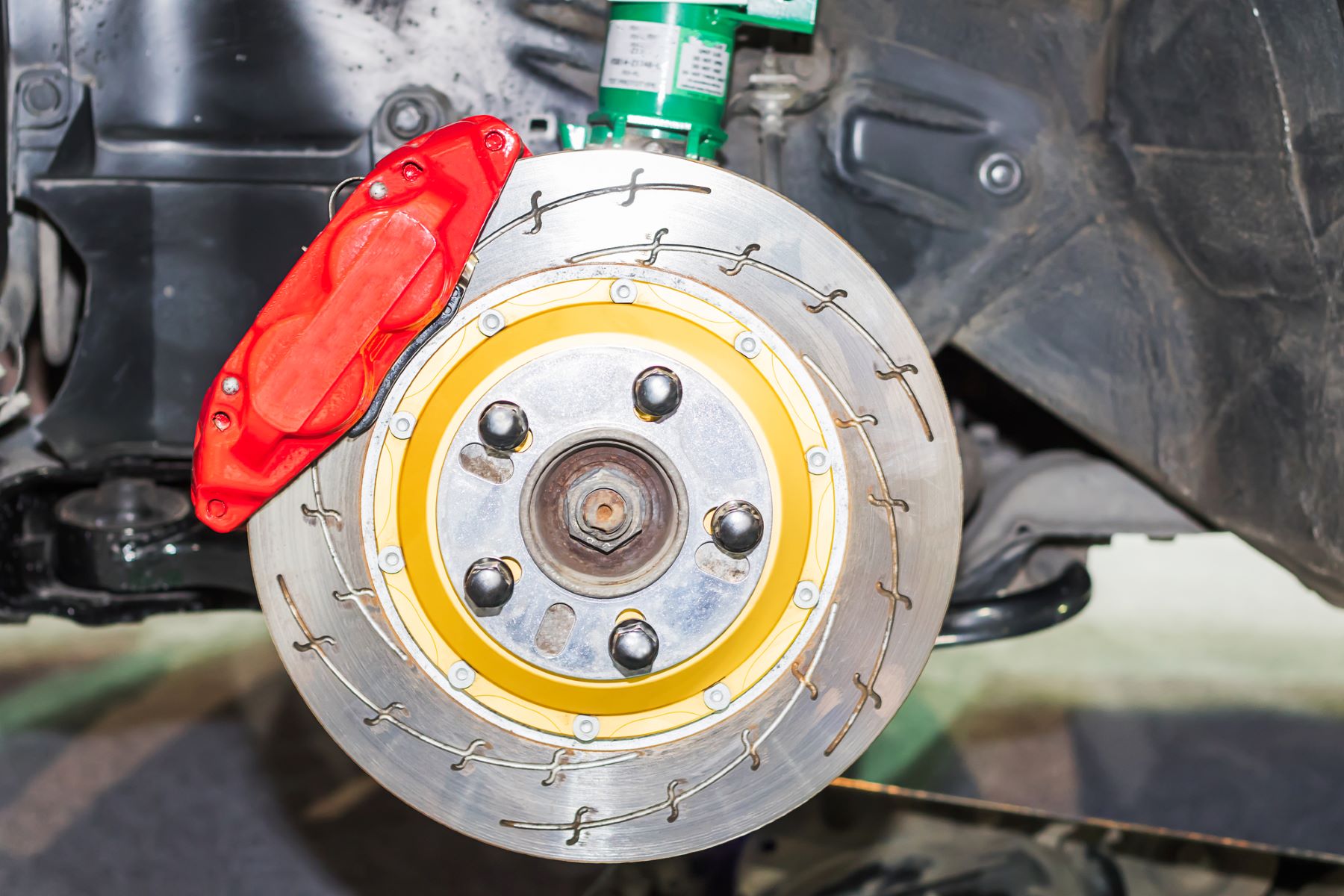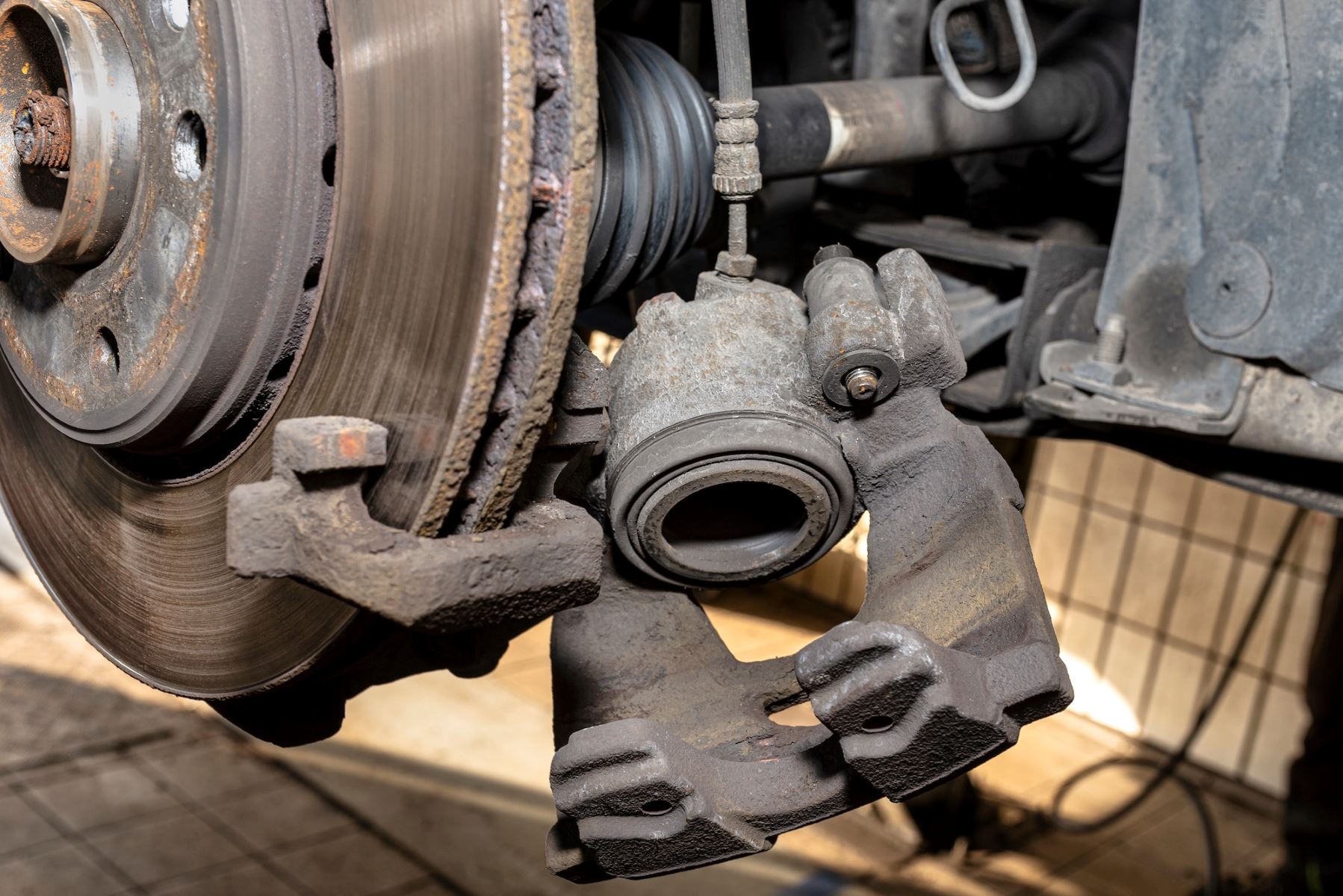Home>Automotive>5 Signs Your Caliper Is Sticking – Don’t Ignore These Red Flags!


Automotive
5 Signs Your Caliper Is Sticking – Don’t Ignore These Red Flags!
Published: January 22, 2024
Discover the top 5 signs of a sticking caliper in your automotive system. Don't overlook these crucial red flags - learn how to address the issue today!
(Many of the links in this article redirect to a specific reviewed product. Your purchase of these products through affiliate links helps to generate commission for Regretless.com, at no extra cost. Learn more)
Table of Contents
Introduction
Your car's braking system is a critical component for ensuring safety on the road. Among the various parts that contribute to effective braking, the caliper plays a pivotal role. It is responsible for squeezing the brake pads against the rotor, creating the friction needed to slow down or stop the vehicle. However, when the caliper malfunctions or gets stuck, it can lead to serious safety hazards and costly repairs. Understanding the signs of a sticking caliper is crucial for maintaining the performance and safety of your vehicle.
In this article, we will explore the five key signs that indicate your caliper might be sticking. By being attentive to these red flags, you can address the issue promptly and prevent potential accidents or extensive damage to your vehicle. Whether you are a seasoned car enthusiast or someone who simply wants to ensure their vehicle's optimal performance, being aware of these signs can save you from the inconvenience and danger of driving with a faulty caliper.
So, let's delve into the telltale signs that your caliper might be sticking, and learn how to address these issues before they escalate into more severe problems. Keep an eye out for these signs, as they could be the early warnings that your car's braking system needs attention.
Read more: 5 Clear Signs Your Transmission Is Slipping
Sign 1: Uneven Brake Pad Wear
One of the primary indicators of a sticking caliper is the presence of uneven brake pad wear. When the caliper fails to release properly after applying the brakes, it can cause the brake pads to remain in contact with the rotor, leading to accelerated and uneven wear. This uneven wear pattern is often noticeable during visual inspections of the brake pads.
Upon examining the brake pads, you may observe that one pad appears significantly more worn down than the other. In some cases, the inner or outer pad may exhibit excessive wear, while the opposite pad shows minimal wear. This stark contrast in wear patterns is a clear indication that the caliper is not functioning as it should, causing uneven pressure on the brake pads.
Moreover, uneven brake pad wear can also result in a reduction in braking efficiency and increased stopping distances. As the brake pads wear unevenly, the frictional contact with the rotor becomes compromised, leading to diminished braking performance. This can manifest as a longer braking distance or a noticeable decrease in the responsiveness of the brakes.
Furthermore, prolonged driving with uneven brake pad wear can lead to additional complications, including damage to the rotor and other braking system components. The continued friction and pressure exerted on the rotor due to the sticking caliper can result in premature wear and potential warping of the rotor surface. This not only amplifies the repair costs but also poses a safety risk due to compromised braking performance.
Addressing the issue of uneven brake pad wear caused by a sticking caliper is imperative to ensure the safety and functionality of your vehicle's braking system. By recognizing this early warning sign, you can take proactive measures to rectify the underlying problem and prevent further damage to crucial braking components.
In summary, uneven brake pad wear serves as a visual cue that your caliper may be sticking, necessitating prompt attention to avoid safety hazards and costly repairs. By staying vigilant and addressing this issue in a timely manner, you can uphold the integrity of your vehicle's braking system and maintain optimal safety on the road.
Sign 2: Vehicle Pulling to One Side
When your vehicle exhibits a tendency to pull to one side while braking, it can be a strong indication of a sticking caliper. This phenomenon occurs due to the uneven application of braking force, resulting from the caliper failing to release properly after the brakes are disengaged. As a consequence, one wheel experiences greater resistance from the brake pads, causing the vehicle to veer in the direction of the affected wheel during braking.
The pulling sensation can be subtle at first, often mistaken for road camber or tire-related issues. However, as the sticking caliper persists, the pulling becomes more pronounced and noticeable, especially during moderate to hard braking. This can be a disconcerting experience for drivers, as the vehicle's deviation from a straight path compromises both safety and driving comfort.
In addition to the pulling sensation, drivers may also observe uneven tire wear on the affected side of the vehicle. The increased friction and resistance experienced by the wheel with the sticking caliper can lead to accelerated wear on that tire. This uneven tire wear is a result of the imbalanced braking force exerted on the wheels, highlighting the underlying issue of the sticking caliper.
Furthermore, the pulling effect can contribute to steering instability and compromised handling, particularly during emergency braking or evasive maneuvers. This poses a significant safety concern, as the vehicle's ability to respond predictably to sudden braking or steering inputs is compromised by the pulling caused by the sticking caliper.
It is important for drivers to be attentive to the subtle changes in their vehicle's behavior, especially during braking, as these can serve as crucial indicators of potential braking system issues. When the vehicle consistently pulls to one side during braking, it is essential to have the braking system thoroughly inspected by a qualified technician. Addressing the underlying cause, such as a sticking caliper, is vital for restoring the vehicle's braking performance and ensuring safe, predictable handling during braking maneuvers.
In summary, the sensation of a vehicle pulling to one side during braking is a compelling sign of a sticking caliper, necessitating prompt attention to rectify the issue. By recognizing this symptom and taking proactive measures to address the sticking caliper, drivers can uphold the safety and performance of their vehicle's braking system.
Sign 3: Overheated Wheels
Overheated wheels are a critical red flag that often points to a sticking caliper within the braking system. When a caliper becomes stuck in the engaged position, it continuously applies pressure to the brake pads, leading to excessive friction and heat generation. This sustained pressure and friction cause the affected wheel to become significantly hotter than the others, manifesting as overheated wheels after driving, especially following prolonged or repeated braking.
One of the primary indicators of overheated wheels is the presence of a distinct burning smell emanating from the affected wheel or brakes. This odor is often described as acrid or burnt, indicative of the intense heat generated by the friction between the brake pads and the rotor. Additionally, the overheated wheel may exhibit visible signs of smoke or steam emanating from the brake assembly, particularly after the vehicle comes to a stop following extended driving.
Furthermore, overheated wheels can lead to adverse effects on the surrounding components, including the brake fluid and the wheel bearings. The intense heat generated by the sticking caliper can elevate the temperature of the brake fluid, potentially causing it to deteriorate and lose its effectiveness. This can compromise the overall performance of the braking system and lead to brake fluid contamination, necessitating thorough inspection and potential replacement.
Moreover, the excessive heat produced by the sticking caliper can impact the wheel bearings, potentially causing them to overheat and degrade prematurely. This can result in decreased bearing lifespan and compromised wheel performance, posing a safety risk and requiring costly repairs if left unaddressed.
Recognizing the signs of overheated wheels is crucial for promptly identifying a sticking caliper and mitigating potential safety hazards. Upon observing the presence of a burning smell, smoke, or steam emanating from the wheels, it is imperative to address the issue immediately to prevent further damage to the braking system and associated components.
In summary, overheated wheels serve as a clear indicator of a sticking caliper, necessitating immediate attention to mitigate safety risks and prevent damage to critical braking components. By being vigilant and responsive to the signs of overheated wheels, drivers can uphold the safety and functionality of their vehicle's braking system.
Sign 4: Spongy Brake Pedal
The sensation of a spongy or mushy brake pedal is a notable indication of a potential issue with the braking system, often linked to a sticking caliper. When a caliper fails to retract fully after the brakes are released, it can lead to a buildup of hydraulic pressure within the brake lines, resulting in a spongy brake pedal feel. This phenomenon is attributed to the compromised ability of the caliper to release the brake pads from the rotor, leading to inadequate brake fluid return and pressure release.
Drivers may notice that when they apply the brakes, the pedal feels soft and lacks the expected firmness and responsiveness. Instead of a reassuring and immediate response from the brakes, there is a noticeable sponginess, requiring increased pedal travel to achieve the desired braking effect. This compromised pedal feel can be disconcerting and alarming for drivers, as it undermines their confidence in the vehicle's braking performance.
Furthermore, the spongy brake pedal sensation can be accompanied by a prolonged braking distance and reduced overall braking effectiveness. As the caliper fails to release fully, the brake pads continue to exert friction on the rotor, leading to a delayed disengagement and diminished braking force. This can result in a longer stopping distance, especially during emergency braking situations, posing a significant safety risk for the driver and other road users.
In addition to the spongy pedal feel, drivers may also experience brake fade, where the braking power diminishes over repeated or sustained braking. This can be attributed to the compromised release of the brake pads due to the sticking caliper, leading to increased heat buildup and reduced frictional contact between the pads and the rotor. As a result, the brakes may exhibit decreased effectiveness and a gradual loss of stopping power, further emphasizing the impact of a sticking caliper on the overall braking performance.
Addressing the issue of a spongy brake pedal caused by a sticking caliper is crucial for restoring the integrity and responsiveness of the braking system. By promptly diagnosing and rectifying the underlying caliper issue, drivers can regain confidence in their vehicle's braking performance and ensure safe and predictable braking maneuvers.
In summary, the sensation of a spongy brake pedal serves as a compelling sign of a sticking caliper, necessitating immediate attention to restore the effectiveness and responsiveness of the braking system. By recognizing this symptom and taking proactive measures to address the sticking caliper, drivers can uphold the safety and performance of their vehicle's braking system.
Read more: 5 Signs That A Jinn Is Haunting Your House
Sign 5: Burning Smell and Smoke
The presence of a burning smell and smoke emanating from your vehicle's wheels is a compelling and unmistakable sign of a potential sticking caliper within the braking system. This distinct odor, often described as acrid or burnt, is indicative of intense heat generated by the friction between the brake pads and the rotor. When a caliper fails to release properly after braking, it continues to apply pressure to the brake pads, leading to excessive heat buildup and the characteristic burning smell.
Upon detecting the distinct odor of burning, drivers should promptly address the issue to mitigate potential safety hazards and prevent damage to critical braking components. Additionally, the presence of smoke or steam emanating from the affected wheel following prolonged or repeated braking serves as a visible indicator of the intense heat generated by the sticking caliper.
The burning smell and smoke not only signify the immediate presence of a sticking caliper but also highlight the potential risks associated with prolonged driving under such conditions. The intense heat produced by the sticking caliper can have detrimental effects on the surrounding components, including the brake fluid and the wheel bearings. The elevated temperature of the brake fluid due to the sustained pressure and friction can lead to its deterioration, compromising the overall performance of the braking system and necessitating thorough inspection and potential replacement.
Furthermore, the excessive heat generated by the sticking caliper can impact the wheel bearings, potentially causing them to overheat and degrade prematurely. This can result in decreased bearing lifespan and compromised wheel performance, posing a safety risk and requiring costly repairs if left unaddressed.
Recognizing the signs of a burning smell and smoke is crucial for promptly identifying a sticking caliper and taking proactive measures to mitigate potential safety hazards. By being vigilant and responsive to these indicators, drivers can uphold the safety and functionality of their vehicle's braking system and prevent further damage to critical components.
In summary, the presence of a burning smell and smoke serves as a clear and compelling indicator of a sticking caliper, necessitating immediate attention to mitigate safety risks and prevent damage to critical braking components. By promptly addressing the issue and rectifying the sticking caliper, drivers can uphold the safety and performance of their vehicle's braking system.
Conclusion
In conclusion, recognizing the signs of a sticking caliper is crucial for maintaining the safety and performance of your vehicle's braking system. Uneven brake pad wear, vehicle pulling to one side, overheated wheels, a spongy brake pedal, and the presence of a burning smell and smoke are all compelling indicators of a potential issue with the caliper. By being attentive to these red flags, drivers can proactively address the underlying problems and prevent safety hazards and costly repairs.
Upon observing uneven brake pad wear, it is essential to promptly address the sticking caliper to prevent further damage to crucial braking components. The visual cue of uneven wear patterns serves as an early warning sign, prompting drivers to seek professional inspection and rectification of the caliper issue. Additionally, the sensation of the vehicle pulling to one side during braking underscores the need for immediate attention to restore safe and predictable handling. By addressing the sticking caliper, drivers can regain confidence in their vehicle's braking performance and ensure a smooth, straight path during braking maneuvers.
Furthermore, the presence of overheated wheels, accompanied by a distinct burning smell and smoke, signifies the urgent need to mitigate potential safety hazards. Drivers should promptly address the sticking caliper to prevent further damage to critical braking components and associated systems. Additionally, the sensation of a spongy brake pedal and the potential onset of brake fade emphasize the impact of a sticking caliper on the overall braking performance, necessitating proactive measures to restore the system's effectiveness.
By recognizing these signs and taking proactive measures to address a sticking caliper, drivers can uphold the safety and functionality of their vehicle's braking system. Timely inspection and rectification of caliper issues can prevent safety hazards, minimize repair costs, and ensure a reliable and responsive braking system.
In essence, staying vigilant and responsive to the signs of a sticking caliper is paramount for ensuring safe and enjoyable driving experiences. By addressing these red flags promptly, drivers can maintain the integrity of their vehicle's braking system and uphold the highest standards of safety on the road.














